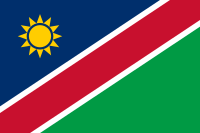Flags of Namibia
| National flag of Namibia | |
|---|---|
 |
|
| Vexillological symbol : |
|
| Aspect ratio: | 2: 3 |
| Officially accepted: | March 21, 1990 |
The first flags of Namibia were from the beginning of the 20th century. The Germans were already planning their own flag for their colony of German South West Africa . After that, British and South African flags were used. The homelands in South West Africa had their own flags. The national flag of Namibia was officially adopted when it gained independence on March 21, 1990. There are also various other national, political and regional flags.
National flags
National flag
The Subcommittee on National Symbols ( English National Symbols Sub-Committee ) of the Constituent Assembly of Namibia , among others consisting of Hidipo Hamutenya and Andrew Matjila , was the selection of a flag, a coat of arms and national anthem was commissioned. From various designs, the committee selected three by Theo Jankowski (* 1951; teacher) from Rehoboth , Don Stevenson (American designer, who has lived in Namibia since 1981) from Windhoek and Ortrud Clay (* 1941, teacher) from Lüderitz , who formed the basis for the flag.
Jankowski supplied the colors red, blue and green as well as white with three stars. The first three colors were taken from the SWAPO flag by him . Clay's flag design was primarily based on blue color, while Stevenson also adopted the colors of SWAPO.

construction
The appearance of the national flag was laid down in Annex 6 of the Namibian constitution .
The national flag of Namibia should have the aspect ratio 2: 3 (h: w), divided by three ascending, diagonal stripes in blue, white and green. The diameter of the white stripe is one third of the width of the flag and is covered by a red stripe that is one quarter of the width of the flag. In the upper corner facing the flagpole there is a golden sun with twelve straight rays, the diameter of these is a third of the flag height. The center is a fifth of the flag's length from the mast and equidistant from the top edge and the white band. The rays are two fifths of the solar radius in length and are separated from the solar disk by a blue ring that is one tenth of the solar radius wide.
Meanings
Although no special meanings were officially assigned to the colors, a representative of the committee explained them as follows:
- Red stands for Namibia's most important resource, the population. It refers to their heroic behavior and the common will to achieve a future with equal opportunities for all.
- White stands for peaceful coexistence and unity.
- Green stands for vegetation and fertility.
- Blue represents the sky and the Atlantic, as well as valuable water reserves and rain.
- The golden yellow sun stands for life and vitality, energy and warmth. The 12 rays of the sun are a symbol for the different ethnic groups.
Presidential flag
The South African counterpart, which was used until 1994, was used as a model for the design of the President's standard . The base is divided horizontally, blue above, green below. There is a golden triangle on the entire width with the tip towards the flight part. The coat of arms of Namibia rests in the triangle . The flag is only used in the home country. Abroad, the President flies the national flag.
2: 3 Standard of the President
Police flag
The flag of the Namibian police was similar to the national flag until the end of October 2009. Here the green area has been replaced by another blue area and the otherwise usual sun by the police star. The new police flag was introduced on November 1, 2009. By integrating the national flag, this should clarify the bond with the country.
2: 3 flag of the Namibian Police since November 1st, 2009
Military flag
The flag of the Namibian Defense Force (Namibian Armed Forces) shows the coat of arms of the NDF on a white triangle, which is flanked by a red and light blue triangle in opposite directions.
Regional flags
Rehobother Baster
The Rehobother Baster come from Boers from South Africa and women from the Nama . In 1868 they founded Rehoboth in what is now Namibia. In 1872 they adopted their own square flag, the colors of which were black, white and red , indicating German influence in the region. The Baster were also one of the first tribes to sign a protection treaty with the German Empire. As a semi-autonomous, political unit called Basterland , they used their flag until Namibia's independence. In a rectangular version, it is still used by the Basters today, and it blows around the administration building of Rehoboth.
 ? Today's form
? Today's form
Caprivi Strip
On October 7, 2002, the Itengese people (" Caprivians ") declared their home region to be independent of Namibia as the Free State of Caprivi Strip . However, this was not recognized by the central government. The government-in-exile of the Caprivi African National Union (CANU) adopted a flag that is based on the flag of the former homeland. Three horizontal stripes in blue, white and green, supplemented by two narrow red stripes at the interfaces. Two black elephants on it. Here the elephants symbolize the national unity and cohesion of Itengesia. The colors come from their history and also from the nature of the country. Blue stands for fate, loyalty and humility, as well as for the sky, rivers and lakes. White represents enlightenment and virtue, as well as unity and peace. Green symbolizes the Caprivi Strip , agriculture and natural resources. The narrow red stripes represent the fight for freedom.
Political flags
Parties
The flag of SWAPO, Namibia's largest party , has been in use since 1971. Their colors are said to come from the tradition of the Ovambo, the largest ethnic group in the country. The SWANU carries a similar flag, but with two golden stripes. The Congress of Democrats is different : its flag shows a gold star with a white border on a narrow white cross on a blue background.
Historical flags
South West Africa
Like the other German colonies, German South West Africa only used the flags of the German Empire . In 1914 there was a proposal for a separate flag for the colony of German South West Africa, but this was never put into practice. During the First World War , South African troops occupied South West Africa; the German troops surrendered on July 9, 1915. After the conquest of Windhoek, General Louis Botha set the Red Ensign of South Africa , which was widely used by the population of South Africa, although it was actually the trade flag and the Union Jack was officially used on land . In 1928 South Africa received a new flag, which was now also used in its mandate area South West Africa.
3: 5 ? 6th flag proposed by German South West Africa in 1914


3: 5 ? 7th flag proposed by German South West Africa in 1914


1: 2 ? Red Ensign of South Africa, in South West Africa 1915 to 1928

1: 2 ? Union Jack, official flag of South Africa until 1928

2: 3 ? Flag of South Africa, in South West Africa 1928 to 1990

Homelands
Based on the South African model, homelands ( Bantustans ) were also founded in what was then South West Africa from 1968 . Although they were reintegrated into South West Africa in 1980, they disappeared as an administrative unit with independence in 1990, along with their flags.
In 1973 Ovamboland was the first to receive its own flag. Blue symbolized the sky, white symbolized peace and green symbolized agriculture. The seven tribes of the Ovambo were symbolized by the green lines.
In 1979 a flag for Damaraland was presented, but not officially adopted due to political resistance. Even so, the flag was used as a unifying symbol. The white and brown flag shows a border post with eight points, which are supposed to represent the eight tribes of the country.
The Kavangoland received its flag as early as 1973 . The green flag was complemented with three narrow horizontal stripes in orange, white and blue. The green symbolized the landscape of the country that is rich in water by Namibian standards. Orange, white and blue were taken from the flag of South Africa.
Ostcaprivi first used a horizontal blue-white-blue striped flag with two black spoons in the center. This was very similar to the flag of the South African homeland Gazankulu , which is why a new flag was introduced in 1977. It showed four horizontal stripes in black, white, green and blue and two black elephants facing each other. The two elephants represented the two main tribes of the country, the Mafwe and the Masubia . Black and white symbolized the population, green the agriculture and blue the surrounding waters.
2: 3 ? Kavangoland



 ? Ostcaprivi , until 1977
? Ostcaprivi , until 1977
2: 3 ? Eastern Caprivi


See also
literature
- Whitney Smith , Ottfried Neubecker : coats of arms and flags of all nations. Battenberg, Munich 1980, ISBN 3-87045-183-1 .
Web links
- Flags of the World - Namibia (English)
Individual evidence
- ↑ a b Flags of the World - Namibia
- ^ Promulgation of National Anthem of the Republic of Namibia Act, 1991 (Act 20 of 1991), of the National Assembly. Government Gazette, Republic of Namibia, December 17, 1991.
- ↑ a b The Namibian flag: Its origins and spirit that inspire the nation. Kundana, June 14, 2018.
- ↑ The National Flag of Namibia, Constitution of Namibia from 1990, Appendix 6 ( page no longer available , search in web archives ) Info: The link was automatically marked as defective. Please check the link according to the instructions and then remove this notice. Retrieved April 4, 2011
- ^ National symbols of Namibia
- ^ Flags of the World - Namibia - President
- ^ Flags of the World - Namibian Police
- ^ New Flag for Police, The Namibian on allafrica.com, August 3, 2009
- ↑ Flags of the World - Baster Area (Rehoboth)
- ^ Flags of the World - Caprivi African National Union
- ^ Flags of the World - Namibia - political parties
- ^ Flags of the World - Flag History of Namibia
- ^ Flags of the World - South African Red Ensign
- ↑ Flags of the World - Bantustans in South West Africa (Namibia)

























